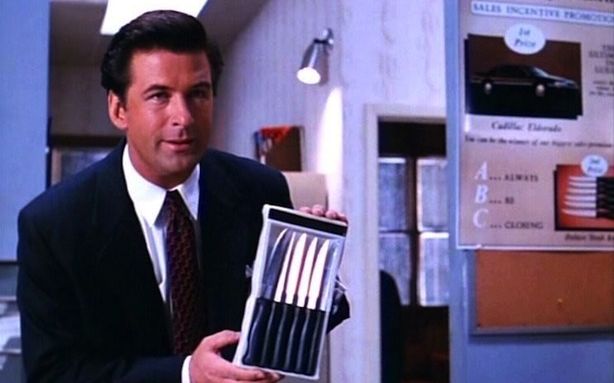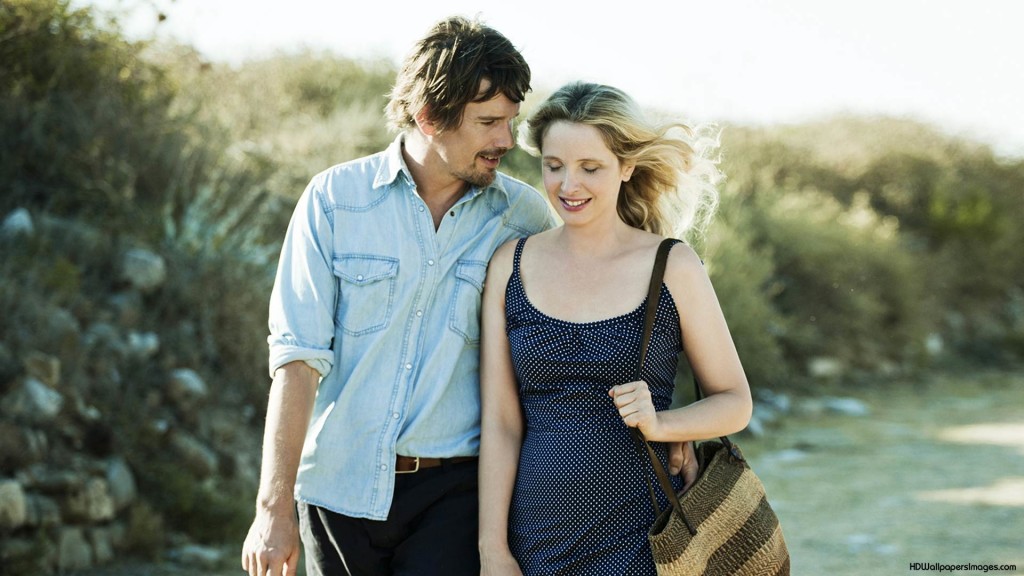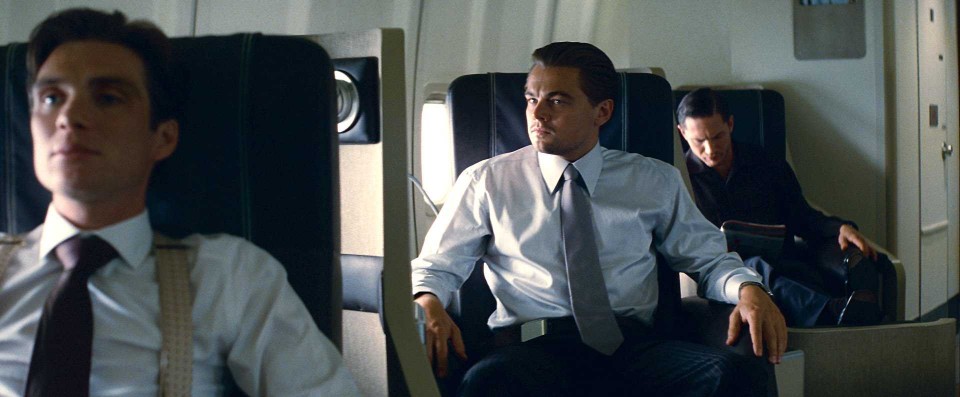Earlier this week, I broke down Do The Right Thing, with a focus on dialogue. I’m fascinated by dialogue as it continues to be one of the most elusive aspects of screenwriting. There are a small percentage of writers out there who are so gifted in this area that they don’t need any help. But chances are, you’re not one of them. And you’re never going to be. I’m sorry, but it’s the truth. People who were born with that gift are no different from basketball players with a 50 inch vertical. No matter how hard you work at it, you’re never going to have a 50 inch vertical.
But here’s the good news, just like there are a hundred NBA players who don’t have a 50 inch vertical, there are hundreds of screenwriters making a living who aren’t great at dialogue. Wanna know the secret to how they survive? They know how to put their characters in situations that create INTERESTING dialogue. Note the difference. “Great” dialogue is David Mamet. It’s creating something out of nothing like he did with Alec Baldwin’s monologue in Glengarry Glen Ross: “Cause the good news is — you’re fired. The bad news is you’ve got, all you got, just one week to regain your jobs, starting tonight. Starting with tonight’s sit. Oh, have I got your attention now? Good. ‘Cause we’re adding a little something to this month’s sales’ contest. As you all know, first prize is a Cadillac Eldorado. Anyone want to see second prize? Second prize’s a set of steak knives. Third prize is you’re fired. You get the picture? You’re laughing now? You got leads. Mitch and Murray paid good money. Get their names to sell them! You can’t close the leads you’re given, you can’t close shit, you ARE shit, hit the bricks pal and beat it ’cause you are going out!!!”
But you don’t need to be David Mamet to succeed. You just need to create dialogue that keeps us interested. And the best way to do that is to set your dialogue up to succeed. Give your characters a situation that will ALLOW them to say interesting things. Almost all of this happens long before your scenes are written. You do it, by and large, by creating characters that naturally interact with each other in dramatic ways. Below, you’ll find 10 approaches to scene-writing that, if done right, should improve your dialogue dramatically. 90% of your scenes (or more) should include one of the following set-ups.
HEAD-BUTTING
One of the most obvious ways to create interesting dialogue is through conflict – having your characters butt heads. How intensely they butt heads will depend on the characters, the story and the individual situation. The most obvious form of this is “arguing.” Characters let loose and rail against one another. Be careful with these scenes though. They typically only work after the pressure has been building up for a long time. If your characters argue right away (although there are exceptions to this) it will feel “on-the-nose” to the reader. And remember, full-on arguing isn’t the only “conflict” option. Sometimes a simple disagreement can be enough to power a scene.
TENSION
Tension is like conflict’s little cousin. It resides right underneath the surface. As such, it’s often a precursor to head-butting. Look at “The Heat,” with Sandra Bullock and Melissa McCarthy. Or Han Solo and Obi-Wan Kenobi in Star Wars. Or Columbus and Tallahassee in Zombieland. There’s tension between all these characters. Sometimes it bubbles up into full on head-butting, but usually it’s like an annoying little mosquito in a tent buzzing in the character’s ear. Needless to say, the pent-up frustration this tension causes always works its way into dialogue in interesting ways.
SEXUAL TENSION
One of the easiest ways to write scenes is to have some sort of sexual tension between your hero and the romantic interest. Sexual tension only works, though, until your characters seal the deal (with a kiss, or sleep together, depending on what type of story it is). Sexual tension can occur in a single scene, such as when Will Hunting tries to pick up Skylar at the bar in Good Will Hunting, or it can drive a multitude of scenes and even an entire movie, like it does in When Harry Met Sally.
SUSPENSE
Tease the reader with something they want, then don’t give it to’em right away. Here’s a scenario that shows the power of suspense. Let’s say our hero, Dan The Detective, shows up at a murder scene. Just before he walks in the house, he gets a call from his wife. She reminds him that he needs to pick up their son after school. She asks if everything’s okay. They discuss a few more things. He finally hangs up and goes inside. Boring right? Here’s how to use suspense. When Dan shows up, have a cop come up to him, face white, shaking his head, and tell Dan that what he’s about to see inside is unlike anything he’s seen in 30 years on the force. “You’re not ready for this,” he tells Dan. Dan, and us, start to go inside, but oh no, Dan’s wife calls! The two have the exact same conversation as before. This time, though, the dialogue feels more alive for some reason. Why? Because of our anticipation. Because we can’t wait to see what’s inside.
RESISTANCE
Resistance is when one character wants something and another character doesn’t want to give it up. One of the most famous examples of this happens in Raiders of the Lost Ark, when Indy goes to get the medallion from Marion. But guess what? She doesn’t want to give it up. In The Avengers, Black Widow tries to convince Bruce Banner to join the Avengers team. He doesn’t want to. In Fargo, Marge wants to get those license plate numbers from Jerry Lundergaard (who doesn’t want to give them to her because he’s secretly stolen the cars). If you want to double the power of Resistance in a scene, have both characters want something and have both sides resist. In the Alec Baldwin Glengarry Glen Ross scene mentioned above, Baldwin wants to give his damn speech. But nobody wants to listen. Also, everybody wants those golden Glengarry Glen Ross leads, but Baldwin doesn’t want to give them away. Resistance is a powerful way to keep dialogue interesting and should be used in the majority of your scenes.
AVOIDANCE
Avoidance is when characters don’t talk about things that need to be talked about. You’ll use Avoidance most often with characters who’ve known each other for awhile. Girlfriends, boyfriends, husbands, wives, family in general. As we all know, people in any relationship get to a point where they’d rather bury their problems than deal with them. When these people talk to each other, you can feel their words dripping with subtext. One need only sit at a family dinner to know how to write one of these scenes. There are usually many things that people are thinking that they’re not saying for one reason or another. Often, they’ll talk about anything else to fill the silence.
CHARACTER DRAMATIC IRONY
Dramatic Irony is a fancy way of saying “someone’s got a secret.” So all you’ve gotta do is write a scene with two characters, where one of the characters is keeping a secret from the other. In other words, almost every scene from Breaking Bad. Walter is keeping from his wife, his kid and his brother-in-law, that he’s a drug dealer. So whenever he has conversations with them, we’re drawn in. It can also be scene specific. In Inception, when Cobb approaches Robert Fischer (once he’s inside Robert’s mind), Cobb’s secret is that he’s trying place information inside Fischer’s mind. Dramatic Irony scenes tend to be the most interesting, however, when it’s the “bad guy” who has the secret. Because in these cases, we’re worried for our hero’s safety. So in Die Hard, when John McClane meets Hans Gruber up on the roof and Hans pretends to be a hostage, we know Gruber’s secret, and are terrified it’s going to result in our hero’s death.
STORY DRAMATIC IRONY
This second version of dramatic irony is the famous Hitchcock example of a bomb under the table. It occurs not when the characters keep secrets from each other, but when the movie keeps a secret from its characters. You’ll see this in horror movies a lot. Imagine a happy couple enjoying a hike through the forest. Chances are, their conversation is going to be pretty boring. But let’s say at the beginning of their hike, we cut to deep in the forest where a crazed maniac with an axe is watching them. When we cut back to them talking, it’s going to be a lot more interesting, isn’t it? We’re worried for them and want them to find out about the psychopath.
COMEDY
One of the ways to make a scene interesting is to make it funny. Have the characters talk about funny things. Seth Rogen and James Franco talking about joints in Pineapple Express. Or in a romantic comedy, when the characters first start hanging out together. This Honeymoon Period should contain a lot of funny dialogue. But beware of resting on comedy alone to sell a scene. If you’re just trying to make your characters say funny shit, we’ll feel the pointlessness of the scene and start to get restless. Often, comedy should be coupled with one of the other options I’ve listed. For example, a lot of the humor in The Hangover doesn’t come from Alan (Zach Galifianakis) and Stu (Ed Helms) just trying to say funny things. It comes from the fact that there’s so much tension between them, from them always butting heads. Also, it should go without saying that if your script is heavily dependent on comedy scenes, you need to be sharp, witty, clever, and funny. This may seem obvious, but I’ve read upwards of 200 amateur comedies where I didn’t laugh once.
PHILOSOPHY
These scenes involve characters talking about fascinating shit. The scenes’ strength rests on how compelling that shit is. Have you heard of something cool you’ve never heard anybody else discuss before? Have you thought of something crazy that nobody else has thought of? Use your characters to introduce these ideas to the world. Potential subjects include God, UFOS, death, life, conspiracies, existentialism, philosophy. These scenes should contain the kind of dialogue that if someone were sitting nearby in a coffee shop, they’d drop what they were doing to listen in. Richard Linklater has become famous for this kind of dialogue in his Before Sunrise movies, Slacker and Waking Life. Woody Allen incorporates it into his scripts as well. It should be noted, however, that this dialogue is really hard to pull off. Most people who think they have interesting thoughts about the world just rehash the same stuff we’ve heard in a hundred other movies (or on the internet). Sure, when it’s done right, we get Before Sunrise. But when it’s done badly, we get Scenic Route. What’s Scenic Route? Exactly.
EXPOSITION SCENES
I’m including these scenes for one reason – because I don’t want you to write them. You should try to avoid, with all your might, writing scenes that are solely dedicated to exposition or backstory. Why? Because exposition and backstory are boring. Instead, break your exposition up into pieces and hide it inside all the other types of scenes I’ve mentioned. I admit this becomes harder to do for fantasy and sci-fi scripts though. With these films, there’s so much more information that needs to be given to the reader, that it’s tempting to write a scene that takes care of all of it. In these cases, just make sure that the exposition is really freaking interesting, like when we learn about the matrix in The Matrix. But I’m telling you, if you have more than even one of these scenes in your script, your reader’s already getting bored.
IN SUMMARY
When I read bad scripts, it’s often because there’s no conflict, no tension, no suspense, no dramatic irony. I’ve actually read hundreds of scripts that didn’t have a SINGLE scene with any of these things in them. You’d think that just by accident you’d write one of these scenes. Guys, these are the cornerstones of dramaturgy. You have to learn them. Now go through your current script. Make sure almost every scene is doing one of these things. And don’t be afraid to stack them. You can have scenes with sexual tension and dramatic irony. You can have scenes with tension and suspense. Get creative. Have fun. And most importantly, use these tools to elevate your dialogue.




